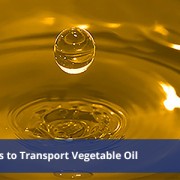A Birdseye View Of The Flexitank Market 2018 – 2026
All liquids that are not categorized as dangerous or hazardous can be transported with the help of flexitanks. The flexitanks are nothing but large flexibags bags used to transport large quantities of liquid. Research shows that they are the preferred transportation material for edible liquids, like cooking oils, wines and fruit juices. In fact, 30 percent of the wine from across the world is transported in flexitanks.
Demand of Flexitanks
The demand for flexitanks is expected to significantly increase in the Asia Pacific region. This is primarily because the region is one of the leading producers and exporters of liquids, including aerated and non-aerated beverages, industrial liquids, vegetable oils, water, and industrial liquids. Hence, the demand for flexitanks in the Asia Pacific region will continue to grow from 2016 to 2026, at the rate of 14.3% CAGR.
Flexitank revenue in the Asia Pacific region in 2018 is predicted to reach a whopping US$159.4 million. This is primarily because it is more economical to transport bulk liquid using flexitanks, even though the cost of one unit of flexitank is higher than the cost of drums or intermediate bulk container.
The global flexitank market is dominated by a few leading manufacturers, who own 50% of the market share. The key players in the global flexitank market are Trans Ocean Bulk Logistics, Global Flexitank Logistics, Trust Flexitanks, Qingdao Global Flexitank Logistics, and Braid Logistics UK.
Cost of Flexitanks
A standard 20-foot container can easily accommodate one flexitank, which has a capacity of 24,000 liters. On the other hand, to transport the same volume, an exporter would require 18 to 20 units of IBC tanks and 80 units of drums.
Related: https://fluidflexitanks.com/rishi-fibc-flexitanks-can-reduce-transport-cost/
With flexitanks, there is no worry about renting as is the case with ISO tanks. Also, the exporter does not have to worry about the duration of the journey or returning the rented tanks when using flexitanks. Hence, flexitanks are more affordable, and this is spurring demand for these bags.
Read more: Flexitanks for Bulk Liquid Transportation
Meeting the Demand
Flexitank manufacturers are increasing the production capacity of flexitanks in India and China.
Qingdao Hengxin Plastic announced in 2018 it would be increasing the production of flexitanks to 200,000 units. The company has been manufacturing these bags for more than 10 years, and in June 2017, it sold about 100,000 flexitanks.
Even the US manufacturers of flexitank are increasing production due to rise in customer demand. This was obvious from the announcement made by Environmental Packaging Technology, located in Zeeland, Michigan.
In India, Rishi FIBC Pvt Ltd, a leading manufacturer of flexitanks, has expanded its production capacity by developing a massive 180,000-square-feet of production facility in Mysore, Karnataka. It will be using this facility to produce world-class flexitanks in addition to other bulk packing products.
The Bottom Line
With emerging economies of Brazil, India, South Africa, Chile, Thailand, Indonesia, and Argentina along with China being the major exporters of edible liquids, there is no doubt that the demand for safe, tamper-proof, spill-proof and economical liquid packaging will increase. From 2018 to 2026, Latin America, South Africa, and the Asia Pacific will be the highest users of flexitanks. These are the regions where large quantities of non-hazardous liquids are produced and exported to all corners of the globe.
We appreciate your feedback and you can leave your comments on the blog below.
Contact Us: +91 484 237951 / +91-2662-305000


